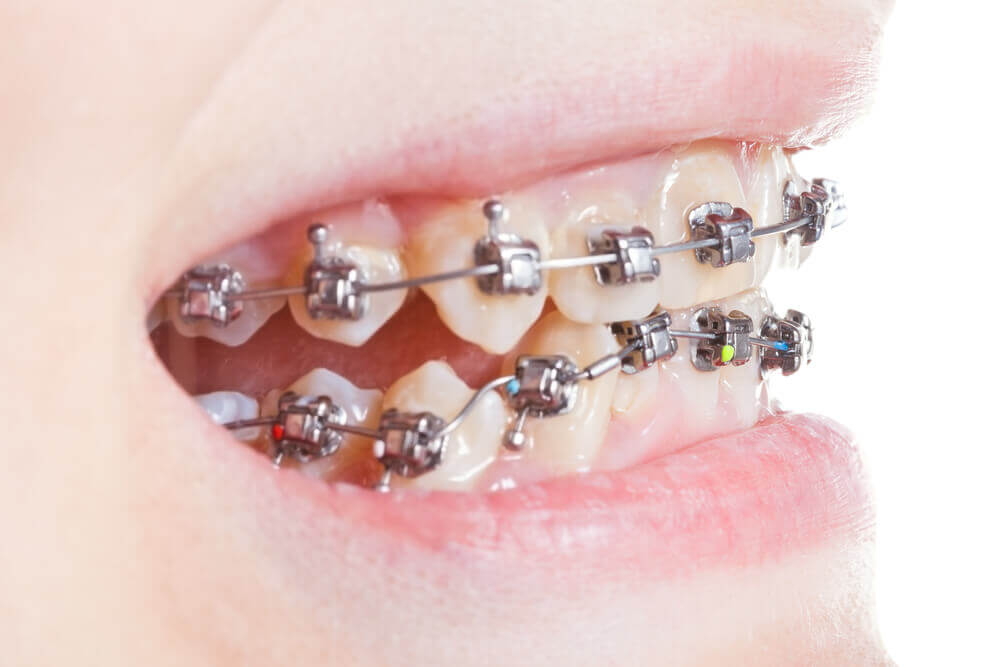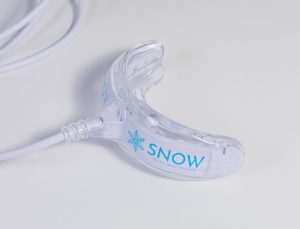Have you ever wondered how to get rid of white spots on teeth? You’re not alone. They are sometimes barely noticeable, but for others it can make you self-conscious of your smile. Aesthetically speaking, white spots on teeth are certainly no fun.
A beautiful smile with a set of bright, white teeth is what everybody wants. But unfortunately, white blotches on the surfaces of teeth can get in the way, despite a healthy oral routine.
So, if you’ve always wondered what these white spots are and how to get rid of them, read on!
In This Article
- 1 What are white spots on teeth?
- 2 What causes white spots on teeth?
- 3 White spots on teeth after braces
- 4 White spots on teeth after whitening
- 5 White spots on babies' teeth
- 6 How to get rid of white spots on teeth
- 7 Video on how to get rid of white stains on teeth
- 8 How to prevent white stains on teeth?
- 9 Conclusion
- 10 FAQs
What are white spots on teeth?
Sometimes also known as white spot lesions on teeth, dental white spots appear due to a condition called hypoplasia. It usually indicates an anomaly in the tooth development process. The shade of these spots is different from the usual shade of our teeth, and they can even appear as marks or stripes on the surface.
During tooth formation, if your body doesn’t get enough minerals, these white blotches can appear. A study from the National Center of Biotechnology Information (NCBI) suggests that demineralization of the tooth enamel is a contributing factor in white stains on teeth. It's more than a cosmetic concern. The fact is, that these spots can be a sign of much bigger problems like tooth decay and weak dental enamel.
The following video should be able to give you a better understanding of the condition.
Needless to say, the presence of white marks on teeth can lead to aesthetic problems and lower your self-esteem. The issue can be worrisome for people with braces as well. If you don't take proper care of your teeth, you can develop white spots from braces.
What causes white spots on teeth?
White spots, or enamel hypoplasia, can occur on your teeth due to several internal or external reasons, including medications, diet, orthodontic treatment, and more. Though there are a few common reasons, it’s best to consult a dentist who can explain the cause for your particular case.
Fluorosis
If children intake large amounts of fluoride during the process of teeth formation, fluorosis can occur. Sources of fluoride can include fluoridated water, fluoride supplements, and swallowing toothpaste or mouthwash rich in fluoride elements.
Although fluoride is very important for the formation of strong tooth enamel and protection from tooth decay, it can also be detrimental if taken in large quantities. It can also cause enamel discoloration, which often leads to chalk-white teeth.


Bacterial overgrowth
Overgrowth of bacteria can also contribute to white spot formation. Your mouth is a highly acidic environment that's great for bacterial growth. If you consume something acidic in nature, you're adding fuel to the fire.
Saliva and bacteria, when combined together, can also lead to dental plaque buildup, which is detrimental to your oral health.
Diet
Teeth are made of calcium, and if they’re deprived of it, the enamel can break down. To avoid this, you should include calcium-rich food like almonds, dairy products, and leafy greens in your diet. Avoiding acidic foods can also reduce the chances of developing white spots on teeth. Acidic foods cause acid reflux, which triggers enamel breakdown.
Braces
Quite often, people who wear braces notice white spots on their teeth after their braces are removed. The reason for this is improper cleaning of teeth around the braces. Cleaning teeth thoroughly when you have braces is usually tricky, and in some cases, plaque or food debris may accumulate around the braces and lead to staining.
The only way to prevent this is brushing and flossing properly around your braces. This guide will help you understand how you can maintain good oral hygiene with braces.
Enamel hypoplasia
Enamel hypoplasia is a dental condition where the enamel is thinner than usual. It is brought on by inherited traits, nutritional deficiencies, drugs prescribed to the mother before giving birth, preterm births, or tooth trauma.
Medications
Antibiotics like amoxicillin can potentially interact with the way your body absorbs nutrients and can impact the tooth enamel. Also, it becomes easier for bacteria to eat through tooth enamel when you’re on antibiotics. Tetracycline is an antibiotic that used to be given to children, although instead of white spots, it would result in grey and brown stripes on teeth.
White spots on teeth after braces
Many individuals find that braces are a great option since they not only provide them a perfectly straight smile, but also a number of health advantages. In some cases, though, people have white spots on their teeth after the braces come off.


Usually, white spots should start to vanish within a few weeks or months with normal tooth brushing and good oral hygiene. However, to entirely remove them, you may also need to seek professional dental care.
White spots on teeth after whitening
People may see unexpected white spots on their teeth after teeth whitening. White spots are not brought on by teeth whitening, but there's a potential that teeth whitening may make any existing white stains on your teeth more noticeable.
White spots on babies' teeth
If your kid has a little white spot on their teeth, you likely want to know what it is and how it got there. White spots on baby teeth are often an indication of dental decay or an excess of fluoride in your child's diet.


Decay and cavities:
White spots on babies' teeth are often early indications of tooth decay in children. Along your child's gumline, these white spots may show up as a chalky, light color. They will ultimately become brown or yellow if the decay doesn't stop.
The good news is that the decay is still reversible at this stage! The dentist will remove any plaque and tartar from your child's enamel and possibly provide a mild fluoride treatment.
Fluorosis:
Adding fluoride to your child's diet via toothpaste is important for their dental health. But if used excessively, it may become an issue. Your toddler's teeth may have developed white spots as a result of excessive fluoride exposure.
When infants or young children consume too much fluoride while their teeth are still growing under their gums, it may result in fluorosis. These fluorosis-related white spots typically have a blotchy or streaky appearance. The ADA recommends the following:
- Until your baby is at least six months old, breastfeed (if possible)
- When brushing your child's teeth, watch out that they don't swallow toothpaste
- Give your child fluoride supplements only if a dentist or doctor prescribes them
- Fluoride-containing mouthwash shouldn't be used in your child's oral hygiene regimen until they are at least six years old
How to get rid of white spots on teeth
There are several possible ways to treat white spots on your teeth. But to find the most suitable treatment, your dentist must identify the root cause. They might suggest one of the following treatments.
Enamel microabrasion
Enamel microabrasion is effective at achieving uniform teeth color. In this procedure, the dentist will remove a small amount of enamel from your teeth using lightly abrasive tools. Often dentists follow it with a bleaching session for improved results and visible whiteness. You may not be eligible for the procedure if you have a certain level of enamel degradation.
Topical fluoride
People with enamel hypoplasia may have topical fluoride applied to their teeth by a dentist. This might promote the growth of enamel on the teeth and guard against tooth decay. Also, read our article on how to remineralize your teeth.
Teeth bleaching or whitening


This method is widely used to reduce the appearance of white spots or any other teeth stains. It involves a simple chemical treatment with one of two teeth bleaching agents: hydrogen peroxide or carbamide peroxide.
These active ingredients are safe for use on your teeth and will break up the white spots into small stains. It makes them less noticeable, and as a result your teeth appear brighter. Though external bleaching agents can help in some cases, their effectiveness really depends on the root cause of the white spots.
Now, if you don't have the budget for professional teeth whitening just yet, you might want to try using a home whitening kit first. The results will vary depending on what has caused the white spots in the first place. But if nothing else, having whiter teeth will make any white patches less noticeable.
Snow makes one of the best professional home whitening kits around, and it comes with with a money-back satisfaction guarantee. Read more details in our full review of Snow.
There are some other methods too, such as over-the-counter whitening strips and toothpastes that you can consider for similar results. They are also available online and are less strong than professional bleaching solutions. You could also consider opting for natural teeth-whitening treatments. Some common ones are coconut oil pulling, cleaning teeth with activated charcoal, or using homemade whitening toothpastes.
Porcelain veneers
Also called porcelain laminates or dental veneers, these are thin protective coverings that are attached to the surface of the teeth and conceal white spots and stains effectively. They are customizable and can be designed by your dentist for your unique tooth color and shape. Your dentist will use specialized tools to bond veneers to your teeth, and multiple visits may be required to complete the procedure.
Resin infiltration
Resin infiltration is a restoration method for enamel lesions. The minimally invasive technique usually involves removal of the less porous outer enamel layer to allow the resin composite (which is composed of teeth bleaching agents) to absorb into the tooth. The resin penetration, when repeated over a prescribed period of time, leads to lighter white spots to the point that they become almost unnoticeable.
Here’s a breakdown of the suggested methods and treatments.
Benefits | Risks | Cost | |
Enamel microabrasion | Eliminates irregularities and discoloration | Mechanical procedure with small concentration of HCl can damage tissues | $100-$300 per tooth |
Professional bleaching | Aesthetic whitening | Increased tooth sensitivity | $300-$900 |
Porcelain veneers | Permanent and resist tooth decay and stains | Rare and minor, but could cause permanent tooth sensitivity | $500-$2,500 per tooth |
Resin infiltration | Less invasive, less expensive, and can be done quickly | Newer procedure; long-term results are unknown | Contact your dentist |
Video on how to get rid of white stains on teeth
To learn more about what causes white spots and how to remove these white stains from teeth, watch the following video.
How to prevent white stains on teeth?


Maintaining great oral hygiene may help avoid dental issues including tooth decay, gum disease, white spots on teeth, and other stains.
The American Dental Association (ADA) advises using fluoride toothpaste while brushing their teeth twice a day and flossing once a day.
Using water without fluoride
Making baby formula milk using fluoride-free water may help avoid an excessive accumulation of fluoride in the teeth of babies who predominantly consume infant formula.
Testing well water
If a person's house is connected to a private well, they should think about getting their water tested annually for fluoride levels. Anyone with small children should adhere to this protocol since natural fluoride levels might vary substantially from one location to another.
Using the appropriate quantity of toothpaste
People should make sure that they are just using a smear of toothpaste, or a quantity the size of a grain of rice, on their toothbrush for children under the age of three. For children over the age of three years, a pea-sized amount of toothpaste is recommended.
Using a tiny quantity of toothpaste may help lower young children's exposure to fluoride since they often fail to spit it out. It might be helpful to watch a youngster brush to make sure they are using the right quantity of toothpaste and aren't ingesting it.
Reducing the use of products high in sugar and acid
Some meals and beverages, particularly those heavy in sugars or acids, may harm tooth enamel and raise the risk of dental decay. This includes, for example, hard candies and other sugary sweets, sodas, and sports drinks.
While consuming certain foods and beverages on occasion may not be harmful, doing so often or in excess might cause damage to the enamel, including white spots on teeth. After eating certain meals, drinking water may help wash them off the teeth and lessen the possibility of harm. Using a straw while drinking may also be beneficial.
Read our article on foods that stain your teeth.
Going to the dentist
It's important to consult a dentist if you, or your child, have white stains on your teeth. White spots on teeth are often not a reason for worry, despite the fact that they may not be visually appealing. However, tooth damage and decay may be more likely to affect those who have enamel hypoplasia.
People should see their dentist if they start to experience tooth discomfort or observe that the size or quantity of the white spots on their teeth is changing. A dentist may assess the signs and the state of the teeth and, if required, propose a treatment plan.
Conclusion
While white spots on teeth aren’t as problematic as other oral issues such as tooth decay and infection, they can be an embarrassing hurdle to getting a perfect smile. The good news, however, is that they’re fairly treatable with a variety of professional and home remedies.
To learn the root cause of the condition, you will want to consult your dentist first and then discuss possible treatments. The best approach would be to take preventive measures rather than opting for treatment later. These include brushing and flossing twice a day, avoiding high quantities of acidic foods, and visiting your dentist regularly.
FAQs
Do white spots on teeth go away?
White spots can go away, or at least minimize in appearance, with the help of corrective treatments. These treatments can include professional or at-home whitening.
How do I prevent white spots on teeth?
There are several things you can do to keep white spots on teeth at bay. For instance, using the right amount of toothpaste for children under the age of 3 is a great place to start. Most children swallow toothpaste while brushing, increasing their exposure to excessive fluoride. This can lead to the development of white stains on teeth.
Adults should minimize the consumption of citrus juices, hard candies, sodas, and drinks with high sugar, which can damage the tooth enamel and increase the risk of tooth decay. All these things can trigger the development of white spots. Additionally, make sure to maintain regular dental visits.
Why do I have white spots on my teeth?
White spots on teeth (lesions) can be a sign of early decay. Common root causes are fluorosis, demineralization of the enamel on the teeth, a low calcium diet, and poor oral hygiene.
What are the white stains on my teeth?
Bacterial plaque can cause demineralization, which results in white spots of decalcification of the enamel of teeth. If treated quickly, the white spots, which are early cavities, may be reversed.
How to get rid of white spots on teeth?
As a preliminary step, your dentist could advise topical fluoride paste to remineralize the teeth. In certain circumstances, conventional teeth whitening with a bleaching agent based on peroxide may be beneficial.
What causes white stains on teeth?


White spots on teeth can be caused by many things, such as too much fluoride, a lack of vitamins, damage to a tooth, bad dental hygiene, dental hypoplasia, a dry mouth, plaque, or acidic foods.
Why do I have white stains on my teeth?
White stains on teeth are the consequence of demineralization, which is caused by the accumulation of bacterial plaque. This is a common problem for those wearing braces.
What do white stains on teeth mean?
Due to persistent bacterial accumulation in the mouth and subsequent mineral loss from the teeth, demineralization results in white areas of decalcified enamel on teeth.
How to remove white spots on teeth?
There are multiple treatment options for removing white stains on teeth. The most common are microabrasion, bleaching and teeth whitening, or veneers. The best option depends on the cause of the stains.
How to get rid of white stains on teeth?
There are many different treatments for getting rid of white stains on teeth, including bleaching, microabrasion, and porcelain veneers, as well as several home remedies.
Benefits / Risks | Cost | More information | |
Porcelain veneers |
| $900-$2,500 per tooth | |
Professional bleaching |
| $300-$1,000 | |
Enamel microabrasion |
| $100-$250 per tooth |
NCBI: In vitro study of white spot lesion. Consulted 5th Sept 2020
NCBI: Microabrasion in tooth enamel discoloration defects. Consulted 5th Sept 2020.
WebMD: Common antibiotic may affect tooth enamel. Consulted 9th Sept 2020.
NCBI: Microabrasion in tooth enamel discoloration defects. Consulted 8th Sept 2020.
Medical News Today: Eleven tips to treat white spots on teeth. Consulted 9th Sept 2020.
Oral Health: Resin infiltration as treatment for an anterior tooth discoloration of developmental origin. Consulted 9th Sept 2020.




